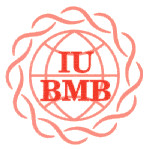Original URL: http://www.chem.qmw.ac.uk/iupac/jcbn/
 | BIOCHEMICAL NOMENCLATURE
COMMITTEES |  |
INTERNATIONAL UNION OF PURE AND APPLIED CHEMISTRY
and
INTERNATIONAL UNION OF BIOCHEMISTRY AND MOLECULAR BIOLOGY
IUPAC-IUBMB Joint Commission on Biochemical Nomenclature (JCBN)
NOMENCLATURE COMMITTEE
of the
INTERNATIONAL UNION OF BIOCHEMISTRY AND MOLECULAR BIOLOGY (NC-IUBMB)
http://www.chem.qmw.ac.uk/iupac/jcbn/
World Wide Web home page maintained by G. P. Moss
Department of Chemistry, Queen Mary and Westfield College,
Mile End Road, London, E1 4NS, UK
G.P.Moss@QMW.AC.UK
Contents
Purpose of the committees
The purpose of the committees is to facilitate communication of biochemical information by encouraging scientists to use generally understood terminology.
They make recommendations with this aim. The committees seek advice from experts in the diverse fields of biochemistry about matters where communication is difficult because of inconsistent practices. This is the starting point of most of the initiatives of the committees. The experts consulted include journal editors and database managers. For example, the recommendations for a Nomenclature for Incompletely Specified Bases in Nucleic Acid Sequences (1984) arose out of an attempt by an international group of experts to resolve the confusion that previously resulted from the existence of many different systems to represent combinations such as "G or C", which had been written in at least five different ways.
Origins
The present nomenclature committees were created by the International Union of Biochemistry (IUB; now the International Union of Biochemistry and Molecular Biology, IUBMB) and the International Union of Pure and Applied Chemistry (IUPAC) to replace the IUPAC-IUB Commission on Biochemical Nomenclature (CBN), which was discontinued in 1977. Formally there are two committees:
- JCBN, the IUPAC-IUBMB Joint Commission on Biochemical Nomenclature
- NC-IUBMB, the Nomenclature Committee of IUBMB
with somewhat different terms of reference. JCBN is jointly responsible to both International Unions, and deals with matters of biochemical nomenclature that have importance in both biochemistry and chemistry. NC-IUBMB is responsible only to IUBMB and deals with matters of biochemical nomenclature that are more remote from the interests of chemists.
In practice there is considerable overlap in the tasks of the two committees and they always work and meet as a single body, with a common Chairman and a common Secretary. The present members are listed on the web. Unless otherwise indicated, therefore, the term "nomenclature committees" in this page refers equally to JCBN and to NC-IUBMB.
Procedures for establishing new recommendations
The initial recommendations for any topic are always prepared by experts in the subject area, but are subsequently studied by the nomenclature committees in an effort to harmonize them with recommendations in related areas of biochemistry, or indeed in chemistry and other disciplines. Although this step often appears unnecessary to experts in a restricted area of the subject, its importance emerges when one attempts to present information on a broader scale or to a broader audience. As an example, some years ago the nomenclature committees were asked to advise on some draft recommendations in which I (in ordinary roman type and without any qualifiers) was proposed as a standard symbol that could be used without definition for a particular immunoglobulin; they had to point out that this could only be acceptable in a very narrow context, as it would be confusing whenever the chemical symbol for iodine might be needed, or if the one-letter code for isoleucine and the symbol for ionic strength were also used (quite apart from confusion with the personal pronoun, as, for example, in "I mixed I with 131I-labelled thyroxine in a solution of I = 0.5 mol/l containing 5mM I"). Further review is required after the nomenclature committees are satisfied with any recommendations, as the International Unions, which have ultimate responsibility for any publication, need to be satisfied that they represent the views of a broad range of experts. The actual review procedures of the two Unions differ somewhat, but their aims are the same, and they also have the additional consequence that preparing any document is inevitably slow. Even the most rapidly produced documents, such as the Nomenclature for Incompletely Specified Bases in Nucleic Acid Sequences noted above, which encountered no serious obstacles on the way to approval, typically take at least two years.
Connections with other bodies
There is inevitably some overlap between the work of the biochemical nomenclature committees and similar bodies in other disciplines, especially other IUPAC commissions and, among these, especially the IUPAC Commission on the Nomenclature of Organic Chemistry (CNOC some of whose documents are available through the web). To avoid arriving at conflicting recommendations the nomenclature committees maintain close relations with such bodies (and during the existence of the present committees they have always included present or former members of CNOC among their members). Input from other committees concerned with biochemical nomenclature is always welcomed, and any such body interested in sending an Observer to meetings of JCBN and NC-IUBMB is invited to contact the Secretary, Professor Cammack.
Publication of recommendations
Apart from Enzyme Nomenclature, discussed below, recommendations of the nomenclature committees are published in the primary research literature. All JCBN recommendations are published in Pure and Applied Chemistry, and all JCBN and NC-IUBMB recommendations are currently published in the European Journal of Biochemistry, by courtesy of FEBS. Many documents appear also in other journals, and any journal wishing to republish a document can normally obtain reproduction-quality proofs from the European Journal of Biochemistry, to avoid the need for re-setting. However, it is not obligatory to use these proofs, and journals that prefer to set the type themselves may do so without any copyright complications. From time to time these documents are published together as a Compendium, Biochemical Nomenclature and Related Documents; the most recent edition was published by Portland Press for IUBMB in 1992 (ISBN 1 85578 005 4).
A list of JCBN and NC-IUBMB publications is available through the web, and the full texts of the following are also there. Others will be added as time permits.
Enzyme Nomenclature
The continuous process of discovering new enzymes requires a somewhat different approach for their nomenclature and classification, which is probably the single largest task of the committees. Information about new enzymes or corrections to existing entries is coordinated in the first instance by Professor K. F. Tipton, and may be reported directly from these web pages or by using the form printed in the back of Enzyme Nomenclature. After the proposed entries have been approved by the committees as a whole, these entries are compiled into supplements to the enzyme list, which have been published in the European Journal of Biochemistry. Such supplements on Enzyme Nomenclature are also available on the web. From time to time there are new editions of Enzyme Nomenclature; the most recent edition was published by Academic Press for IUBMB in 1992 (ISBN 0-12-227164-5 hardback or 0-12-227165-3 paper).
It is perhaps worth noting, as it has been a matter of long-standing confusion, that Enzyme Nomenclature is primarily a matter of naming reactions catalysed, not the structures of the proteins that catalyse them. This results partly from the fact that it is often necessary to have some means of referring to a newly discovered catalytic activity long before anything is known about the structure of the catalyst, and partly from the fact that systematic naming of protein structures (other than in an impossibly cumbersome way by means of the nomenclature of amino acids and peptides) has proved to be a difficult problem that has so far eluded a satisfactory solution. However, the system of naming reactions rather than structures is one that works far better for some classes of enzymes than for others: it is largely satisfactory for the enzymes that catalyse the main pathways of intermediary metabolism, but is much less so for enzymes that handle polymers.
Newsletters
The nomenclature committees publish newletters from time to time in various journals of biochemistry as a way of drawing attention to new recommendations, revisions to existing ones, current problems that are being studied, and to make minor recommendations that are too small to demand a full-scale document. In the future the committees hope that many of these functions will be fulfilled by these web pages. The 1996 and 1999 Newsletters are available.
Procedure for drawing attention to problems of nomenclature
Certain major areas of biochemistry require almost continuous review: the recommendations on carbohydrates, lipids, nucleic acids, proteins and enzymes are in this category, and are inevitably in a continuous state of revision as new discoveries are made. More restricted areas of the subject can have nomenclature that may survive for a decade or more without requiring any changes, but even then there are never any "definitive" recommendations fixed for all time. In the past published recommendations were often described as Rules, but the present committees prefer to avoid this term as far as possible, replacing it with Recommendations, which expresses more accurately their status. It is important to realize that the nomenclature committees do not have (and do not seek to have) any authority to enforce the adoption of their recommendations. Only journal editors have such authority, and follow nomenclature recommendations only to the extent that they choose to do so. In practice the Instructions to Authors of numerous journals do include references to most of the documents prepared by JCBN and NC-IUBMB, but only because this is the policy of the journals themselves.
Any subject can be reexamined, and it is open to any biochemist or other scientist concerned with biochemistry to draw attention to problem areas, whether because no conventions exist or because the existing recommendations fail to take account of the current state of knowledge. The most efficient way to do this is to write to the Secretary of JCBN and NC-IUBMB outlining the problem, and when appropriate suggesting a possible solution.
Last update 18 May, 1999.
Comments and corrections to the Secretary at richard.cammack@kcl.ac.uk
Return to main IUBMB Biochemical Nomenclature home page
Return to main IUPAC Chemical Nomenclature home page

